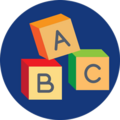Mathematics
At Wayne RESA we believe every student deserves to engage in meaningful learning experiences, in classrooms where teachers position them as capable to innovate, create, and think mathematically and who highlight students’ particular contributions to the classroom community. We support teachers and schools in designing learning experiences that enable all learners to thrive in school, in their community, and in the world.
Instruction
Planning for Ambitious Tier I Instruction
The Thinking Through a Lesson Plan Protocol(TTLP) is used to guide teachers to think deeply about a specific lesson that will be taught. The goal is to move beyond a basic lesson plan to a deeper consideration of how to advance students’ mathematical understanding during the lesson.
Part 1 of the TTLP lays the groundwork for planning before the implementation of the rich math tasks in the classroom. First, identify the learning targets of the lesson. Then, select a high cognitive demand math task aligned to the learning targets from the district’s textbook resource. Next, determine how to launch the task to help students make sense of problem. For example, determine how to activate prior knowledge, make sense of the task and decide which instructional tools will be made available to the students.
Part 2 of the TTLP helps monitor students as they engage in the task during the Explore Phase. Prior to implementing the math task, anticipate strategies and misconceptions students may encounter while solving the task. Based on anticipated strategies, formulate questions ahead of time to clarify and assess student thinking. The rest of the monitoring tool can be completed during the Explore Phase while monitoring and recording the names of students using the anticipated strategies. The monitoring tool will help in selecting and sequencing the students who will share their thinking in the Summarize Phase.
Part 3 of the TTLP focuses on how to orchestrate a whole-group discussion of the task. This discussion uses the different solution strategies produced by students to highlight the mathematical ideas that are the focus of the lesson. Strategically plan the order in which solutions are presented to help develop students’ understanding of the mathematical ideas. In addition, develop questions to ask to make connections between students’ strategies.
Facilitating Meaningful Mathematical Discourse
“Effective teaching of mathematics facilitates discourse among students to build shared understanding of mathematical ideas by analyzing and comparing student approaches and argument.” (Huinker & Bill, 2017).
Teachers need to establish norms for discourse to create a safe environment and ensure equitable participation. Productive talk moves can be used by teachers to engage all students in discussion. Teachers need to think about the goal they are trying to reach based on student responses. Think about the following goals and you determine which talk move to use during discussion.
- Helping Individual Students Clarify and Share their Own Strategies
- Helping Students Orient to the Thinking of Other Students
- Helping Students Deepen their Reasoning
- Helping Students to Engage with the Reasoning of Other
Web Resources
A professional resource for teachers, coaches, and administrators passionate about improving students’ mathematics learning and performance.
Book Resources
Taking Action: Implementing Effective Mathematics Teaching Practices (K-5)
ISBN-13: 978-0873539692
Taking Action: Implementing Effective Mathematics Teaching Practices (6-8)
ISBN-13: 978-0873539753
Taking Action: Implementing Effective Mathematics Teaching Practices (9-12)
ISBN-978- 0-875353-976-0
Children's Mathematics: Cognitively Guided Instruction (Whole Number Operations)
ISBN-13: 978-0325052878
Extending Children's Mathematics: Innovations in Cognitively Guided Instruction (Fractions and Decimals)
ISBN-13: 978-0325030531
Framework for Ambitious Instruction
NCTM has identified eight Mathematics Teaching Practices that research indicates are consistent components of every mathematics lesson. Learners should have experiences that enable them to engage with challenging tasks. . . connect new learning with prior knowledge and informal reasoning. . . acquire conceptual as well as procedural knowledge. . . construct knowledge through discourse, activity, and interaction with meaningful problems. . . receive descriptive and timely feedback. . . develop meta-cognitive awareness of themselves as learners, thinkers, and problem solvers” (NCTM, 2014, p. 9).
Based on these principles, Wayne RESA has created a Framework for Ambitious Instruction.
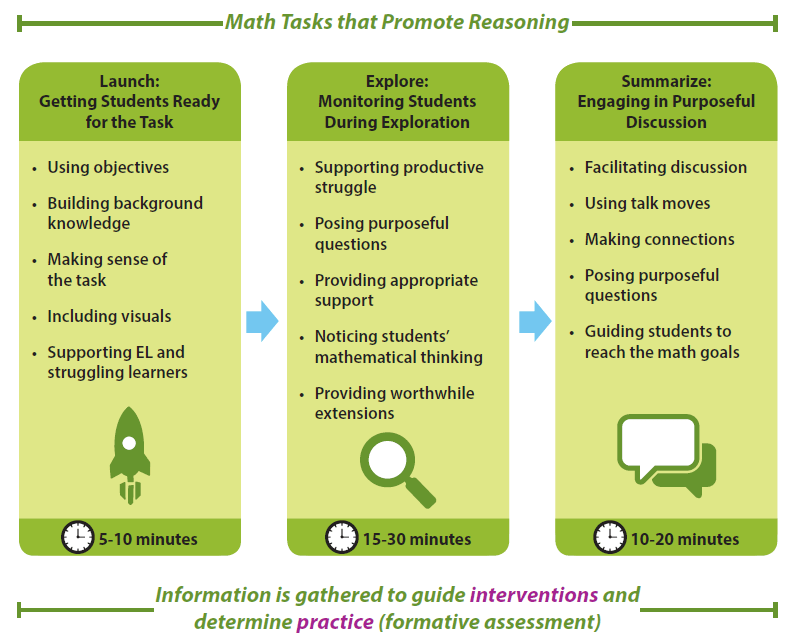
Assessment
An excellent mathematics program ensures that assessment is an integral part of instruction, provides evidence of proficiency [for teachers and students] of important mathematics content and practices, includes a variety of strategies and data sources [which are instructionally sensitive], and informs feedback to students, instructional decisions, and program improvement.”
(NCTM, 2014, p. 89)
Assessment to Inform Instruction
Assessment to Inform Instruction supports teachers in answering the question What comes next in learning?
Among the various methods of assessment for learning are listening to student contributions (both responses and questions students ask to the teacher and of their peers) and analyzing their written work and using that information to interpret student understanding and determine next steps in instruction. An image of student work below shows that the student recognizes there are 16 ounces in a pound and that this problem is multiplicative in nature and that the student has an algorithmic method for solving 16 x 5, as opposed to other methods, such as counting by 5s or using repeated addition.
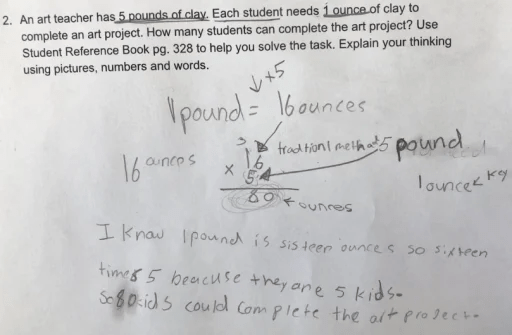 In elementary mathematics, researchers have developed progressions that describe the likely development of student mathematical thinking for a given concept, what we call big ideas in mathematics. For example, addition and subtraction and multiplication and division are big ideas in mathematics. These progressions can guide teachers in making instructional decisions based on a student’s progress as compared to the progression. Below are progressions for grades Kindergarten through Fifth Grade whole number concepts.
In elementary mathematics, researchers have developed progressions that describe the likely development of student mathematical thinking for a given concept, what we call big ideas in mathematics. For example, addition and subtraction and multiplication and division are big ideas in mathematics. These progressions can guide teachers in making instructional decisions based on a student’s progress as compared to the progression. Below are progressions for grades Kindergarten through Fifth Grade whole number concepts.
Diagnostic Assessment
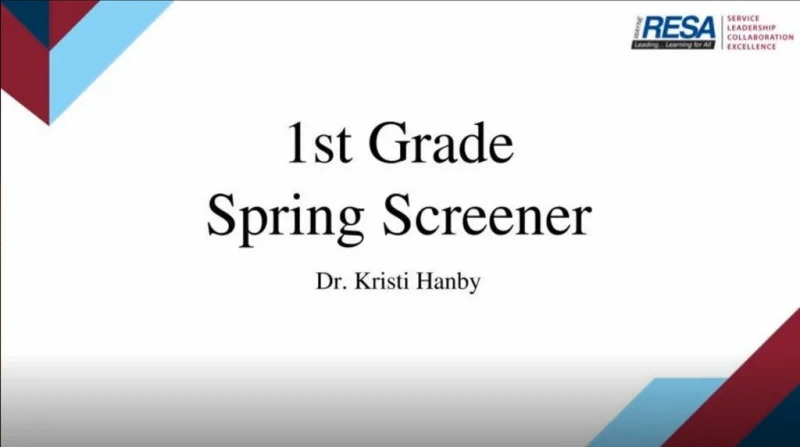 Diagnostic Assessment can be used to identify a students’ strengths as well as areas for improvement, can form the basis for interventions and is often shared with multiple educators in order to plan supports to improve the student’s learning. This short interview-based assessment provides the teacher with information related to the students’ understanding of number, addition and subtraction, place value, and multiplication and can be used to determine if the student is performing at grade level as well as to determine areas of strength or weakness.
Diagnostic Assessment can be used to identify a students’ strengths as well as areas for improvement, can form the basis for interventions and is often shared with multiple educators in order to plan supports to improve the student’s learning. This short interview-based assessment provides the teacher with information related to the students’ understanding of number, addition and subtraction, place value, and multiplication and can be used to determine if the student is performing at grade level as well as to determine areas of strength or weakness.
Interim (Unit Assessments)
Interim (Unit) Assessments support teachers in answering the questions Which standards are our students consistently not mastering? Where can we improve instruction? Which students need specific help? (Stiggins, 2010).
Interim assessments should identify content standards that students are struggling to master as well as the students struggling to meet those standards. Teachers can use this information to improve their own instructional practices aimed at those standards. Additionally, these assessments can help teachers and students focus on identifying student strengths and areas of improvement so they can intentionally plan interventions.
Assessment of Learning
Assessment of Learning supports teachers, schools, and districts in answering the questions What standards are our students consistently not mastering? Where and how can we improve instruction next year? (Stiggins, 2010).
Summative assessments evaluate student learning against intended outcomes. These assessments provide evidence of student achievement and can identify the percentage of students meeting performance expectations on state content standards (Chappuis, 2015).
In Michigan, students are assessed summatively in the spring of each year, starting in 3rd grade. MDE houses Sample assessment items for 3rd - 7th grade M-STEP
Secondary students are Assessed using the PSAT or SAT. Released items can be used in a variety of ways to inform the work that students are doing in the classroom.
Book Resources
| The Formative 5: Everyday Assessment Techniques for Every Math Classroom (Fennell, Kobett, & Wray) ISBN-13: 978-1506337500 |
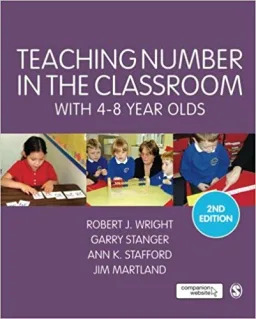 | Teaching Number in the Classroom for 4-8 year olds (Assessment and Intervention) ISBN-13: 978-1446282694 |
 | Developing Number Knowledge: Assessment, Teaching, and Intervention with 7-11 year-olds ISBN-13: 978-0857020611 |
Curriculum Resources
A mathematics curriculum is more than a collection of activities; instead it is a coherent sequencing of core mathematical ideas that are well articulated within and across grades and courses. Such curricula pose problems that promote conceptual understanding, problem solving, and reasoning and are drawn from contexts in everyday life and other subjects. (NCTM, 2014, p. 72).
Content Standards
- Textbook Adoption
- Curriculum Development
- Learning Targets (document?)
- Cognitive Demand Rubric
- Atlas
Web Resources
Professional Development
Mathematics Contacts
-
Cherron Ramsey Mathematics Consultant (734) 334-1547Send an Email
Co-Chair Disciplinary Literacy Taskforce
-
Jeffrey Moore Secondary Mathematics and Continuous Improvement Consultant (734) 334-1549 Send an Email




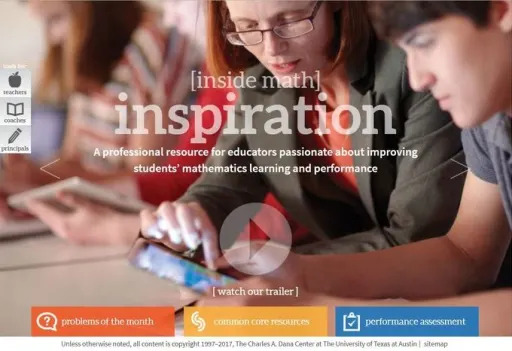 Inside Mathematics
Inside Mathematics

